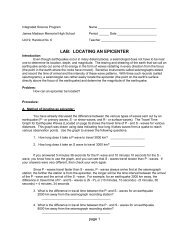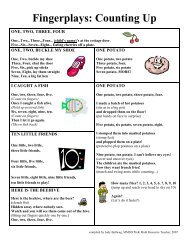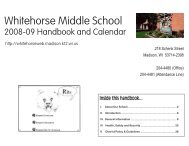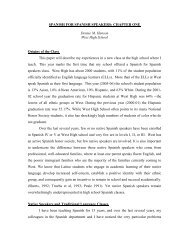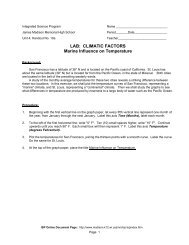The Final Report - Malcolm Shabazz City High School, Madison WI
The Final Report - Malcolm Shabazz City High School, Madison WI
The Final Report - Malcolm Shabazz City High School, Madison WI
You also want an ePaper? Increase the reach of your titles
YUMPU automatically turns print PDFs into web optimized ePapers that Google loves.
PURPOSE AND SCOPE (cont.)<strong>The</strong> decisions facing the District are difficult; the analysis we provide is intended to frame thesedecisions with data about the impact, cost, and policy implications of programs so that Districtdecision makers have the information they need to make informed decisions. At the same time,there were many cases where quantitative data on program effectiveness, impact or successwere not available. In those cases, we attempted to include any available quantitative data,coupled with qualitative information.This functional analysis is intended to provide the District with consistent, objective informationto use in decision making. <strong>The</strong> functional analysis does not make decisions about where theDistrict should target budget reductions. It merely recognizes that the District faces difficultdecisions, and attempts to frame those decisions within a balanced, analytical and objectiveframework.APPROACH AND METHODOLOGY<strong>The</strong> cornerstone of our approach to completing this functional analysis is our decision model.<strong>The</strong> model began with identification of all functions and sub-functions within the District. We thendeveloped categories into which all functions could be divided (see below). Next, we developedscreening criteria – a standard set of variables used to analyze all functions based on howfunctions are categorized. For example, all mandated functions underwent the same analysis,while all instructional discretionary items were analyzed on a distinct set of criteria.Through the application of screening criteria, we identified items where a decision was required.In light of the fiscal constraints facing the District, a decision item was a case where a functionwas material in cost and could be eliminated or reduced (based on the screening criteria).Decision items attempt to frame the potential effects of function elimination or reduction, in lightof data available.In designing the decision model, we embedded two crucial features. First, we took great lengthsto avoid substituting our value judgments for those of District decision-makers. As a result, we donot offer recommendations, but rather frame the budget decision options. <strong>The</strong> second crucialfeature of our model is that all functions are analyzed within the same framework. <strong>The</strong>application of a standard set of functional categories and screening criteria (coupled with anobjective perspective) was intended to foster consistency in analyzing functions across programareas, departments, and divisions within the District.In order to implement this approach, the following tasks were completed:• Each department and division submitted a listing of their functions and sub-functions.• All sub-functions were classified into one of the following functional categories forscreening purposes:Core to Classroom Instruction – providing direct core classroom instruction for the District(e.g. Math instruction)Health and Safety – directly related to the well-being of students or District employees(abandonment would create direct negative impact on health or safety)Mandated (State or Federal) – mandated through specific state or federal statues or legaladministrative rulesInstructional Support – resources directly supporting core classroom instruction (e.g. supportinstruction, equipment, supplies)Virchow, Krause & Company, LLP Page 4March 11, 2002



